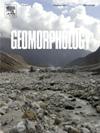利用雨滴大小分布(DSD)测量在黎刹省塔内山区建立土壤侵蚀研究的动能-降雨强度(KE-I)关系
IF 3.1
2区 地球科学
Q2 GEOGRAPHY, PHYSICAL
引用次数: 0
摘要
降雨动能(KE)是土壤侵蚀模拟的重要参数,但在气象观测中很少直接测量。为了改进动能估算,本研究利用雨滴大小分布(DSD)和部署在菲律宾黎萨省塔内山区的OTT Parsivel2分差仪的降雨强度测量数据建立了动能-降雨强度(KE - i)关系。研究人员分析了2023年1月30日至2024年12月31日记录的41次降雨事件,得出了两个降雨侵蚀力指标的KE-I关系:动能消耗(KEexp, J m−2 h−1)和动能含量(KEcon, J m−2 mm−1)。结果表明,幂律模型能较好地描述KEexp-I关系,指数模型最能拟合KEexp-I关系。KEcon一般随降雨强度的增加而增加,但在低强度事件期间观察到更大的变化。KEcon模型在高降雨强度事件中表现更好,在排除降雨率<;1.7 mm h−1后,精度提高了26.4%。此外,结果还表明,不同降雨制度下降雨微物理的变化显著影响KE-I关系。本研究观测到的KEcon最大值在全球平均值(28.3±2.9 J m−2 mm−1)范围内,但由于降雨微物理、气象条件和实验装置的差异,与宿务、台湾和香港等地区有所不同。这些发现强调了开发本地化KE- i模型的重要性,以实现对土壤侵蚀研究和水文应用至关重要的更准确的降雨量KE估算。本文章由计算机程序翻译,如有差异,请以英文原文为准。
Establishment of kinetic energy – Rainfall intensity (KE-I) relationships for soil erosion studies using raindrop size distribution (DSD) measurements in the mountainous region of Tanay, Rizal
Rainfall kinetic energy (KE) is an important parameter in soil erosion modeling, yet direct measurements are rare in meteorological observations. To improve KE estimation, this study develops kinetic energy–rainfall intensity (KE–I) relations using raindrop size distribution (DSD) and rainfall intensity measurements from an OTT Parsivel2 disdrometer deployed in the mountainous region of Tanay, Rizal, Philippines. A total of 41 rainfall events, recorded between 30 January 2023 and 31 December 2024, were analyzed to derive KE-I relations for two rainfall erosivity indicators: kinetic energy expenditure (KEexp, J m−2 h−1) and kinetic energy content (KEcon, J m⁻2 mm⁻1). The results show that a power-law model effectively describes the KEexp–I relation, and an exponential model provides the best fit for the KEcon–I relation. KEcon generally increases with rainfall intensity, but greater variability was observed during low-intensity events. The KEcon model performed better for high rainfall intensity events, with accuracy improving by 26.4 % after excluding rainfall rates <1.7 mm h−1. Additionally, the results also revealed that variations in rainfall microphysics across different rainfall regimes significantly influence the KE-I relationships. The maximum observed KEcon in this study is found to be within the range of the global average values (28.3 ± 2.9 J m−2 mm−1), but differs from other regions like Cebu, Taiwan, and Hong Kong due to differences in rainfall microphysics, meteorological conditions, and experimental setup. These findings highlight the importance of developing localized KE-I models to achieve more accurate rainfall KE estimates essential for soil erosion studies and hydrological applications.
求助全文
通过发布文献求助,成功后即可免费获取论文全文。
去求助
来源期刊

Geomorphology
地学-地球科学综合
CiteScore
8.00
自引率
10.30%
发文量
309
审稿时长
3.4 months
期刊介绍:
Our journal''s scope includes geomorphic themes of: tectonics and regional structure; glacial processes and landforms; fluvial sequences, Quaternary environmental change and dating; fluvial processes and landforms; mass movement, slopes and periglacial processes; hillslopes and soil erosion; weathering, karst and soils; aeolian processes and landforms, coastal dunes and arid environments; coastal and marine processes, estuaries and lakes; modelling, theoretical and quantitative geomorphology; DEM, GIS and remote sensing methods and applications; hazards, applied and planetary geomorphology; and volcanics.
 求助内容:
求助内容: 应助结果提醒方式:
应助结果提醒方式:


